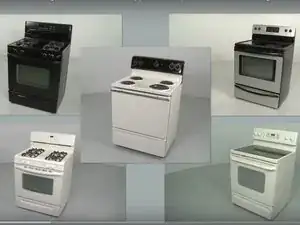
How Does An Electric Stove & Oven Work?
These are some common tools used to work on this device. You might not need every tool for every procedure.
The domestic range, commonly referred to as a stove, was designed as a multipurpose cooking appliance. It consists of a surface area with heating elements on the top to cook food. The oven cavity found in many range devices is used for baking food at a set temperature. Within the same oven enclosure, the broiling of food is incorporated.
Ranges are available as either electric or gas, and come in sizes ranging from 20 inches to 48 inches wide. They also come with a wide selection of configurations and colors. Here are a few common configurations sold to consumers:
| Feature | Freestanding Ranges | Slide-In Ranges | Drop-In Ranges |
|---|---|---|---|
| Placement | Between base cabinets or at the end of a cabinet line | Flush with surrounding counters, ideal for islands or peninsulas | Hangs from countertop or sits on a low cabinet base |
| Fuel Options | Gas or Electric | Gas or Electric | Gas or Electric |
| Size Options | 20, 24, 30, 36, 40, 48-inch widths | Most common in 30-inch width | 27 and 30-inch widths |
| Oven Options | Some 40 and 48-inch models have two ovens | Usually single oven models | Usually single oven models |
| Design Varieties | Various combinations of gas and electric elements | Gas burners, electric elements, glass cooktops | Gas burners, electric elements, glass cooktops |
| Control Locations | Rear console or across the front | Front or side controls | Front controls |
| Oven Cleaning Systems | Self-cleaning, continuous cleaning, manual cleaning | Similar cleaning options as Freestanding Ranges | Similar cleaning options as Freestanding Ranges |
| Advantages | Less expensive, movable, utensil space, front controls, additional storage | Can be installed at varied heights, accessible controls | Flush installation eliminates gaps, customizable height |
| Disadvantages | Rear controls hard to reach, low broiler access in gas ranges | Built into kitchen, not movable, requires professional installation | Built into kitchen, not movable, requires carpenter and electrician for installation |
| Feature | Built-In Cooktops | Built-In Ovens |
|---|---|---|
| Size Options | 15 to 48 inches wide | 24, 27, and 30-inch widths, height varies for single- or double-oven units |
| Design Varieties | Gas burners, standard electric elements, glass cooktops; modular design; plug-in accessories | Single or double oven cavity; combinations include conventional, microwave, or both |
| Control Locations | Side or front controls | Controls vary, depending on model |
| Oven Cleaning Systems | Not applicable | Self-cleaning, continuous cleaning, manual cleaning; two-oven models may offer different systems |
| Advantages | Convenient height installation, accessible controls, open space below, various colors in 30-inch width | Installation at convenient height, automatic cleaning systems, accessible controls for standing or seated users |
| Disadvantages | Built into kitchen, not movable, requires professional installation | Built into kitchen, not movable, may require structural changes and professional installation, learning new cooking techniques for microwave combinations |
In the world of appliance repair and maintenance, knowledge of the individual components of gas ovens, stoves, and ranges is crucial. These appliances are essential in our daily lives, providing us with the means to cook and prepare food. However, their complexity means that a wide variety of parts work together to ensure their proper function. From control mechanisms to cooking elements, each part plays a vital role.
The following table categorizes the key components found in typical gas ovens, stoves, and ranges. This breakdown aims to aid both repair professionals and enthusiasts in identifying parts, understanding their functions, and troubleshooting issues more efficiently. Whether you're performing routine maintenance or tackling a specific repair, this serves as a valuable resource for navigating the intricate world of gas cooking appliances.
| Category | Parts |
|---|---|
| Control Components | Clock and Timer, Thermostat Cap Tube, Internal Plug, Burner Knob, Burner Valve, Gas Manifold |
| Cooking Components | Burner, Cooktop, Oven Burner, Oven Pilot, Oven Burner Air Shutter, Broiler Drawer |
| Structural Components | Burner Grate, Oven Frame Gasket, Oven Door Spring, Hinge |
| Ventilation and Safety | Oven Vent, Oven Safety Valve, Drip Pan |
| Ignition Components | Gas Supply, Flash Tube, Burner Pilot |
A stove is an appliance that generates heat inside or on top of the device. Stoves are primarily designed to cook food.
When humans first started cooking, it was done mainly over an open fire. Initially, cooking vessels were typically placed directly on the fire. By setting the cooking vessel on a support such as a few stones, humans invented the first stove. In fact, the three-stone stove method is still used around the world today. In some regions, the three-stone stove developed into a U-shaped brick or dried mud enclosure. These enclosures include an opening in the front for air and fuel.
Types of stoves include the kitchen stove, the coal-burning stove, and the wood-burning stove. Each stove type varies in efficiency and purpose.
Modern stoves use direct heat for cooking food. They can be identified by the heat source and purpose. They may also include an oven underneath for baking. Stoves were traditionally fueled by wood or coal, but modern versions are also powered by electricity or gas. Some electric stoves also use an induction system which heats the cooking utensil, but not the stove top.
Wood-burning stoves for heating produced in the United States after 1992 are required to emit only a certain number of particulates. Because of concerns about air pollution, deforestation, and climate change, stove design has changed to be more efficient. Especially in very populous countries, innovations in biomass burning-stoves are developing to reduce particulate emissions.